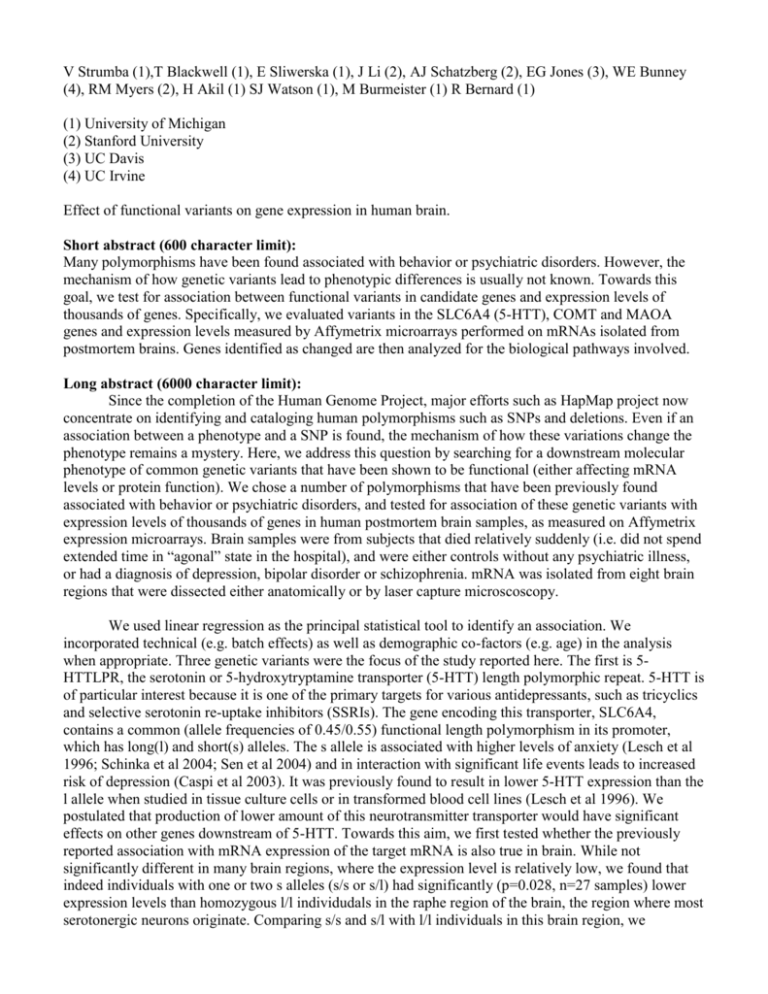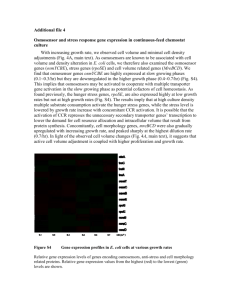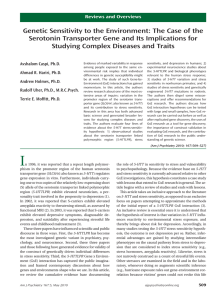Effect of functional variants on gene expression in human brain
advertisement

V Strumba (1),T Blackwell (1), E Sliwerska (1), J Li (2), AJ Schatzberg (2), EG Jones (3), WE Bunney (4), RM Myers (2), H Akil (1) SJ Watson (1), M Burmeister (1) R Bernard (1) (1) University of Michigan (2) Stanford University (3) UC Davis (4) UC Irvine Effect of functional variants on gene expression in human brain. Short abstract (600 character limit): Many polymorphisms have been found associated with behavior or psychiatric disorders. However, the mechanism of how genetic variants lead to phenotypic differences is usually not known. Towards this goal, we test for association between functional variants in candidate genes and expression levels of thousands of genes. Specifically, we evaluated variants in the SLC6A4 (5-HTT), COMT and MAOA genes and expression levels measured by Affymetrix microarrays performed on mRNAs isolated from postmortem brains. Genes identified as changed are then analyzed for the biological pathways involved. Long abstract (6000 character limit): Since the completion of the Human Genome Project, major efforts such as HapMap project now concentrate on identifying and cataloging human polymorphisms such as SNPs and deletions. Even if an association between a phenotype and a SNP is found, the mechanism of how these variations change the phenotype remains a mystery. Here, we address this question by searching for a downstream molecular phenotype of common genetic variants that have been shown to be functional (either affecting mRNA levels or protein function). We chose a number of polymorphisms that have been previously found associated with behavior or psychiatric disorders, and tested for association of these genetic variants with expression levels of thousands of genes in human postmortem brain samples, as measured on Affymetrix expression microarrays. Brain samples were from subjects that died relatively suddenly (i.e. did not spend extended time in “agonal” state in the hospital), and were either controls without any psychiatric illness, or had a diagnosis of depression, bipolar disorder or schizophrenia. mRNA was isolated from eight brain regions that were dissected either anatomically or by laser capture microscoscopy. We used linear regression as the principal statistical tool to identify an association. We incorporated technical (e.g. batch effects) as well as demographic co-factors (e.g. age) in the analysis when appropriate. Three genetic variants were the focus of the study reported here. The first is 5HTTLPR, the serotonin or 5-hydroxytryptamine transporter (5-HTT) length polymorphic repeat. 5-HTT is of particular interest because it is one of the primary targets for various antidepressants, such as tricyclics and selective serotonin re-uptake inhibitors (SSRIs). The gene encoding this transporter, SLC6A4, contains a common (allele frequencies of 0.45/0.55) functional length polymorphism in its promoter, which has long(l) and short(s) alleles. The s allele is associated with higher levels of anxiety (Lesch et al 1996; Schinka et al 2004; Sen et al 2004) and in interaction with significant life events leads to increased risk of depression (Caspi et al 2003). It was previously found to result in lower 5-HTT expression than the l allele when studied in tissue culture cells or in transformed blood cell lines (Lesch et al 1996). We postulated that production of lower amount of this neurotransmitter transporter would have significant effects on other genes downstream of 5-HTT. Towards this aim, we first tested whether the previously reported association with mRNA expression of the target mRNA is also true in brain. While not significantly different in many brain regions, where the expression level is relatively low, we found that indeed individuals with one or two s alleles (s/s or s/l) had significantly (p=0.028, n=27 samples) lower expression levels than homozygous l/l individudals in the raphe region of the brain, the region where most serotonergic neurons originate. Comparing s/s and s/l with l/l individuals in this brain region, we identified a list of >100 genes whose expression level appeared significantly affected by the 5-HTTLPR genotype. Functional analysis of this list of genes may help shed light on the exact mechanism of 5-HTT action. The second variant of interest is an exonic common (0.6/0.4) variant, Val108/158Met, in the catechol-O-methyl-transferase (COMT) gene. The Met allele is known to result in lower enzymatic activity (Lachman et al 1996). This variation has been found in an often replicated study to be associated with cognitive processing ability (Egan et al 2001). We postulated that change in enzymatic activity would also have downstream effects on the expression of other genes, but did not find any statistically significant changes in our data so far. The third variant to be tested is a functional promoter variation in the X-linked gene for the mono-amine-oxidase A, MAO-A, which has been shown to affect mRNA levels in tissue culture (Sabol et al 1998; Samochowiec et al 1999), and has been found associated with risk for conduct disorder and impulsive violent behavior when considered in conjunction with early childhood treatment (Caspi et al 2002). Since the effect of genotype downstream on expression levels of genes is relatively small, it turned out to be important to carefully match or control for other factors. These included technical factors such as batch of chips or hybridizations, as well as demographic factors (e.g. age). In addition, we carefully excluded subjects who were under prolonged agony before death, since this has previously been shown by our group to affect expression of many genes (Li et al 2004). Conflict of interest statement: The authors are members of the Pritzker Neuropsychiatric Disorders Research Consortium, which is supported by the Pritzker Neuropsychiatric Disorders Research Fund L.L.C. A shared intellectual property agreement exists between this philanthropic fund and the University of Michigan, Stanford University, the Weill Medical College of Cornell University, the Universities of California at Davis, and at Irvine, to encourage the development of appropriate findings for research and clinical applications. Literature Cited: Caspi A, McClay J, Moffitt TE, et al (2002): Role of genotype in the cycle of violence in maltreated children. Science 297:851-4. Caspi A, Sugden K, Moffitt TE, et al (2003): Influence of life stress on depression: moderation by a polymorphism in the 5-HTT gene. Science 301:386-9. Egan MF, Goldberg TE, Kolachana BS, et al (2001): Effect of COMT Val108/158 Met genotype on frontal lobe function and risk for schizophrenia. Proc Natl Acad Sci U S A 98:6917-22. Lachman HM, Morrow B, Shprintzen R, et al (1996): Association of codon 108/158 catechol-Omethyltransferase gene polymorphism with the psychiatric manifestations of velo-cardio-facial syndrome. Am J Med Genet 67:468-72. Lesch KP, Bengel D, Heils A, et al (1996): Association of anxiety-related traits with a polymorphism in the serotonin transporter gene regulatory region. Science 274:1527-31. Li JZ, Vawter MP, Walsh DM, et al (2004): Systematic changes in gene expression in postmortem human brains associated with tissue pH and terminal medical conditions. Hum Mol Genet 13:609-16. Sabol SZ, Hu S, Hamer D (1998): A functional polymorphism in the monoamine oxidase A gene promoter. Hum Genet 103:273-9. Samochowiec J, Lesch KP, Rottmann M, et al (1999): Association of a regulatory polymorphism in the promoter region of the monoamine oxidase A gene with antisocial alcoholism. Psychiatry Res 86:67-72. Schinka JA, Busch RM, Robichaux-Keene N (2004): A meta-analysis of the association between the serotonin transporter gene polymorphism (5-HTTLPR) and trait anxiety. Mol Psychiatry 9:197202. Sen S, Burmeister M, Ghosh D (2004): Meta-analysis of the association between a serotonin transporter promoter polymorphism (5-HTTLPR) and anxiety-related personality traits. Am J Med Genet 127B:85-9.









